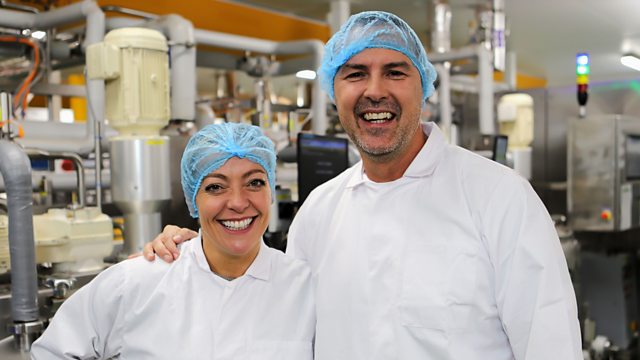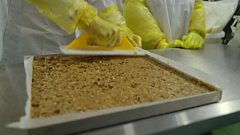Flapjacks
Paddy McGuinness enjoys a lot of taste tests when he visits a factory in London to learn how they produce sticky toffee flapjacks on an epic scale.
In this episode, Paddy McGuinness explores the secrets of the Graze factory in west London, revealing how they make 40 million flapjacks a year.
Armed with a trusty tasting spoon and willing to savour every ingredient, Paddy is following production of the sticky toffee-flavoured, oat-boost flapjack. He begins by meeting manufacturing director Tim Palmer, who is overseeing delivery of a mixture of jumbo oats and small oats. Then, he heads straight into the heart of the factory, the bakery, where head of food Eleanor McClelland will be his guide to sticky toffee success. She tells him that they use two different types of oats because the small oats bind the product together while the jumbo oats add texture. After helping to weigh out the oats, Paddy begins his tasting journey with dried dates, which are added to help give that all-important sticky toffee flavour. He claims it’s his best date of the year. ‘It’s been a while, let me tell you!’
Then, it’s on to the wet ingredients that will bind the flapjacks together. First up, it’s a huge vat of golden syrup. Eleanor tells Paddy the great thing about golden syrup is that it doesn’t crystallise after baking, so it gives a lovely moist texture. After Paddy has had a good, long taste of the syrup, it’s on to black treacle, which helps add the sticky toffee flavour. The two sweet ingredients are put together inside a specialist mixer that helps to combine the other oil and water-based ingredients.
Then the dry and liquid ingredients are all put inside a bit of kit that reminds Paddy of a cement mixer. And just one minute later, perfectly formed flapjack mix is scooped out and loaded onto trays. Paddy tries his hand at the all-important task of smoothing the mixture – it’s more difficult than it looks because the depth of the mixture must be uniform to make sure it bakes evenly.
After baking in a revolving oven, the trays of flapjack mix are cooled and then sent to the packing department, where Paddy catches up with Tim again. Specialist ultrasonic robot cutters are used to slice each tray of flapjack mix into 81 rectangular-shaped flapjacks. The blades of the cutters vibrate up and down 20,000 times a second, guaranteeing the perfect cut. And a clever machine makes sure they’re all lined up correctly for packing – any flapjacks that are the wrong way round are ejected from the conveyor belt by a tiny blast of compressed air.
Finally, 15,000 flapjacks an hour are wrapped, then put into boxes of four before being loaded onto pallets and into the back of a waiting lorry. The whole process takes just ten hours.
Elsewhere in the episode, Cherry Healey visits a mill in Ireland to learn how porridge oats are milled, and she heads to the University of Reading, where she meets a scientist who explains the benefits of oats to our gut health.
Historian Ruth Goodman learns about the fascinating history of another oaty snack, the Staffordshire oatcake, and explores the story of how sugar magnates Tate & Lyle came together to create the iconic golden syrup.
Last on
More episodes
Previous
Clip
-
![]()
"Oh, that's lovely!"
Duration: 01:02
Credits
| Role | Contributor |
|---|---|
| Presenter | Paddy McGuinness |
| Presenter | Cherry Healey |
| Presenter | Ruth Goodman |
| Executive Producer | Lucy Carter |
| Executive Producer | Sanjay Singhal |
| Executive Producer | Michael Rees |
| Director | Sean Casey |
| Production Company | Voltage TV |
Broadcasts
- Tue 21 Jan 2025 20:00
- Sun 26 Jan 2025 18:00���˿��� Two except Northern Ireland & Northern Ireland HD
Learn more about the history of the factory and how it has evolved with an interactive from The Open University.
The fascinating stories behind the production of some of our favourite products.


